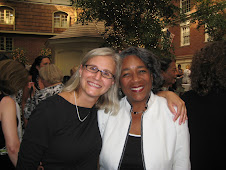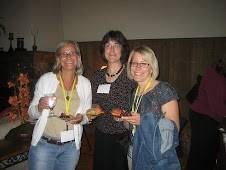After the first
NUA Large Group Sessions, a few teachers in cohorts 4 and 5 decided that they would try the
Augusta Mann dancing definitions strategy that was modeled.
Claris Springob noted that world language teachers often use similar strategies because they need to bring the vocabulary to life for students.
Here’s the summary of the dancing definitions strategy:
1. Teacher writes a rhythmical definition on a poster to display during the teaching. The poster also includes a tag sentence that uses the word in a way that connects to youth culture. The teacher should also consider adding a differentiation word to the definition for those students who already have a strong vocabulary.
2. Teacher recites the definition (repeating the key words of the definition) and tag sentence. The recitation also involves memorable movement(s).
3. Students recite the definition and tag sentence and do the movement two times with the poster visible.
4. The teacher then puts the poster down, and the students recite, from memory, the definition and tag sentence while doing the movement for the fourth time.
5. The poster should then be hung on the wall. Depending on wall space in your classroom, you may have to rotate words every few days.
Here's an example of a definition of a vocabulary word from
The Crucible:
arbitrate: To arbitrate is to judge or decide, judge or decide, a dispute. The umpire will arbitrate the play at first. (motion: the baseball out signal with thumb coming out).
Teacher Responses to the Strategy:Within a few days of the large group, KC West had incorporated the dancing definitions strategy into her English 10 class. The first time that KC taught a word, she told the students that they may find the strategy funny, but that it would help them learn the definitions of their vocabulary words. KC reported that the students really liked the strategy, and she heard students comment: "Wow, I can't believe that I actually remembered that definition." KC also felt that the activity helped build rapport with her students. She felt that they respected her more for taking a chance on a strategy that took her out of her comfort zone.
Scott
Woelber tried a dancing definition with volume in geometry class, and here's his report on how the definition went:
"I actually wrote the definition of volume on poster paper along with an association.
Volume is the amount enclosed. Volume is the amount occupied. The volume of the Metrodome is enormous. The volume of an iceberg is enormous. I said it three times like a chant (but within my comfort level!). The students repeated it back once while looking at it, and then again but with the poster covered. Hand movements were included. This activity went well, but it takes a little convincing that chanting a definition isn't just for little kids!
Some American Literature teachers are planning on trying dancing definitions with the vocabulary words from
The Crucible.
To read more on the strategy, visit this website:
http://www.successfulteachers.com/strategies/dd/dd.html












